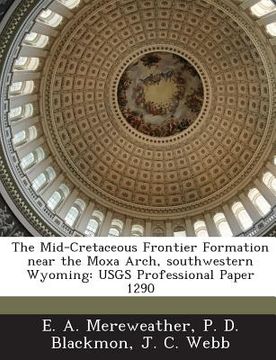The Mid-Cretaceous Frontier Formation Near the Moxa Arch, Southwestern Wyoming: Usgs Professional Paper 1290 (en Inglés)
Reseña del libro "The Mid-Cretaceous Frontier Formation Near the Moxa Arch, Southwestern Wyoming: Usgs Professional Paper 1290 (en Inglés)"
The Frontier Formation in the Green River Basin of Wyoming, Utah, and Colorado, consists of sandstone, siltstone, and shale, and minor conglomerate, coal, and bentonite. These strata were deposited in several marine and nonmarine environments during early Late Cretaceous time. At north-trending outcrops along the eastern edge of the overthrust belt, the Frontier is of Cenomanian, Turonian, and early Coniacian age, and commonly is about 610 m (2,000 ft) thick. The formation in that area conformably overlies the Lower Cretaceous Aspen Shale and is divided into the following members, in ascending order: Chalk Creek, Coalville, Allen Hollow, Oyster Ridge Sandstone, and Dry Hollow. In west-trending outcrops on the northern flank of the Uinta Mountains in Utah, the Frontier is middle and late Turonian, and is about 60 m (200 ft) thick. These strata disconformably overlie the Lower Cretaceous Mowry Shale. In boreholes on the Moxa arch, the upper part of the Frontier is of middle Turonian to early Coniacian age and unconformably overlies the lower part of the formation, which is early Cenomanian at the south end and probably Cenomanian to early Turonian at the north end. The Frontier on the arch thickens northward from less than 100 m (328 ft) to more than 300 m (984 ft) and conformably overlies the Mowry. The marine and nonmarine Frontier near the Uinta Mountains, marine and mnmarine beds in the upper part of the formation on the Moxa arch and the largely nonmarine Dry Hollow Member at the top of the Frontier in the overthrust belt are similar in age. Older strata in the formation, which are represented by the disconformable basal contact of the Frontier near the Uinta Mountains, thicken northward along the Moxa arch and westward between the arch and the overthrust belt. The large changes in thickness of the Frontier in the Green River Basin were caused mainly by differential uplift and truncation of the lower part of the formation during the early to middle Turonian and by the shoreward addition of progressively younger sandstone units at the top of the formation during the late Turonian and early Coniacian. The sandstone in cores of the Frontier, from boreholes on the Moxa arch and the northern plunge of the Rock Springs uplift, consists of very fine grained and fine-grained litharenites and sublitharenites that were deposited in deltaic and shallow-water marine environments. These rocks consist mainly of quartz, chert, rock fragments, mixed-layer illite-smectite, mica-illite, and chlorite. Samples of the sandstone have porosities of 4.7 to 23.0 percent and permeabilities of 0.14 to 6.80 millidarcies, and seem to represent poor to fair reservoir beds for oil and gas. The shale in cores of the Frontier Formation and the overlying basal Hilliard Shale, from the Moxa arch, Rock Springs uplift, and overthrust belt, was deposited in deltaic and offshore-marine environments. Samples of the shale are composed largely of quartz, micaillite, mixed-layer illite-smectite, kaolin, and chlorite. They also contain from 0.27 to 4.42 percent organic carbon, in humic and sapropelic organic matter. Most of the sampled shale units are thermally mature, in terms of oil generation, and a few probably are source rocks for oil and gas.

